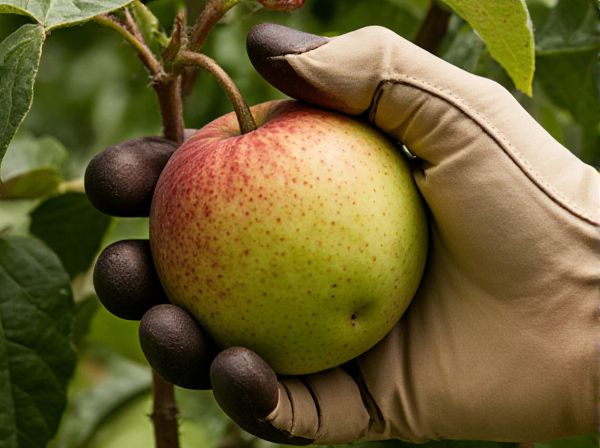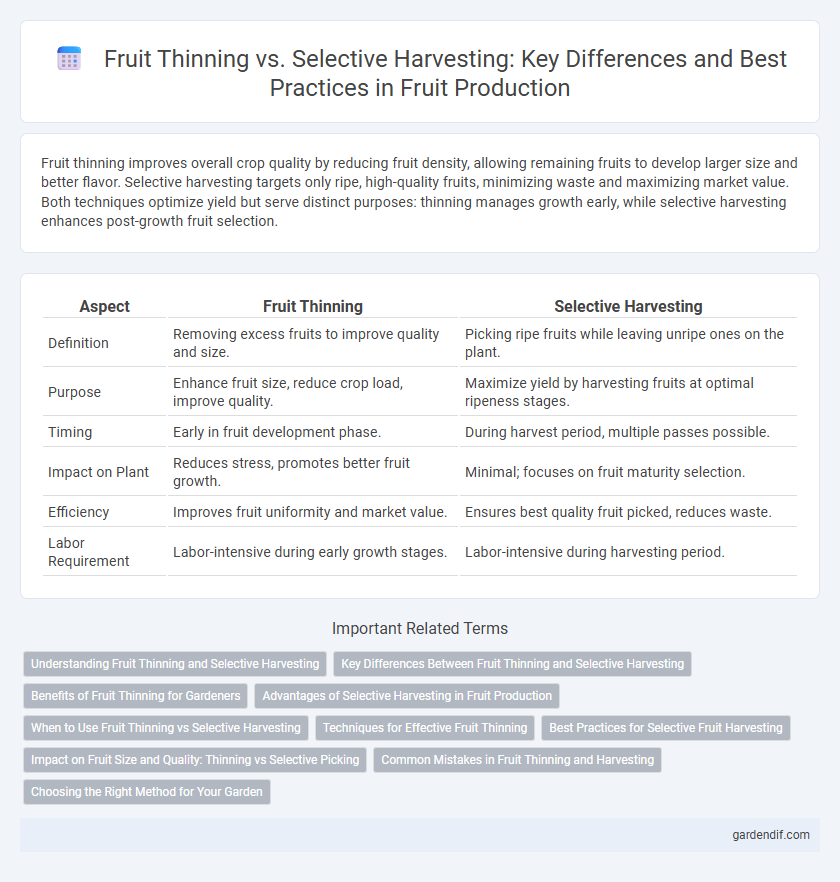
Fruit thinning vs selective harvesting Illustration
Fruit thinning improves overall crop quality by reducing fruit density, allowing remaining fruits to develop larger size and better flavor. Selective harvesting targets only ripe, high-quality fruits, minimizing waste and maximizing market value. Both techniques optimize yield but serve distinct purposes: thinning manages growth early, while selective harvesting enhances post-growth fruit selection.
Table of Comparison
| Aspect | Fruit Thinning | Selective Harvesting |
|---|---|---|
| Definition | Removing excess fruits to improve quality and size. | Picking ripe fruits while leaving unripe ones on the plant. |
| Purpose | Enhance fruit size, reduce crop load, improve quality. | Maximize yield by harvesting fruits at optimal ripeness stages. |
| Timing | Early in fruit development phase. | During harvest period, multiple passes possible. |
| Impact on Plant | Reduces stress, promotes better fruit growth. | Minimal; focuses on fruit maturity selection. |
| Efficiency | Improves fruit uniformity and market value. | Ensures best quality fruit picked, reduces waste. |
| Labor Requirement | Labor-intensive during early growth stages. | Labor-intensive during harvesting period. |
Understanding Fruit Thinning and Selective Harvesting
Fruit thinning involves the deliberate removal of immature fruits to improve the size and quality of the remaining crop, enhancing overall yield efficiency. Selective harvesting targets only mature fruit ready for market, reducing waste and optimizing harvest timing. Both techniques play crucial roles in maximizing orchard productivity by balancing fruit quality and harvest labor.
Key Differences Between Fruit Thinning and Selective Harvesting
Fruit thinning involves the strategic removal of excess fruits during the growing season to improve the size and quality of the remaining fruits, enhancing overall yield efficiency. Selective harvesting is the process of carefully picking only ripe or mature fruits at optimal times, ensuring peak flavor and quality while minimizing waste. The key differences lie in timing and purpose: fruit thinning occurs pre-harvest to regulate fruit load, whereas selective harvesting is a post-growth activity aimed at quality control and market readiness.
Benefits of Fruit Thinning for Gardeners
Fruit thinning enhances sunlight penetration and airflow among branches, reducing the risk of diseases and promoting healthier fruit development. It helps gardeners improve fruit size and quality by preventing overcrowding and ensuring optimal nutrient distribution. This method also reduces tree stress, leading to longer-lasting productivity and easier harvest management.
Advantages of Selective Harvesting in Fruit Production
Selective harvesting enhances fruit production by allowing farmers to pick only ripe, high-quality fruits, which improves overall crop yield and market value. This method reduces waste and pest infestation by leaving immature fruits on the tree for further development. Precise timing in selective harvesting supports better tree health and resource allocation, resulting in more consistent and premium-quality fruit production.
When to Use Fruit Thinning vs Selective Harvesting
Fruit thinning is essential during early fruit development to improve size, quality, and overall yield by reducing overcrowding on trees. Selective harvesting is best applied at mature stages to pick ripe fruits while leaving unripe ones for later collection, optimizing fruit quality and market timing. Choosing between fruit thinning and selective harvesting depends on crop type, growth stage, and desired production outcomes.
Techniques for Effective Fruit Thinning
Effective fruit thinning techniques involve strategically removing immature or excess fruits to enhance the size and quality of the remaining crop. Methods such as manual hand thinning allow precise selection, while chemical thinners like NAA (naphthaleneacetic acid) promote controlled fruit drop, improving overall yield efficiency. Timing and consistency in thinning significantly influence fruit development, ensuring uniform maturation and reducing resource competition.
Best Practices for Selective Fruit Harvesting
Selective fruit harvesting involves carefully choosing ripe fruits while leaving immature ones on the plant to enhance overall crop yield and quality. Best practices include monitoring fruit maturity using color, size, and firmness indicators to ensure peak flavor and nutrient content. Employing gentle handling techniques and proper tools minimizes damage, extending shelf life and market value.
Impact on Fruit Size and Quality: Thinning vs Selective Picking
Fruit thinning improves overall fruit size and quality by reducing the number of developing fruits, allowing the tree to allocate more nutrients to fewer fruits, resulting in larger, more uniform produce. Selective harvesting targets only mature, high-quality fruits, ensuring optimal taste and texture at the time of picking but does not directly influence the size of remaining fruits on the tree. Both methods enhance fruit quality, but thinning has a more significant impact on increasing fruit size through controlled fruit load management.
Common Mistakes in Fruit Thinning and Harvesting
Common mistakes in fruit thinning include over-thinning, which reduces total yield, and under-thinning, causing overcrowded fruits that lack size and quality. In selective harvesting, errors often involve harvesting fruits too early or too late, impacting flavor and market value. Proper timing and technique are crucial to maximize fruit quality and overall orchard productivity.
Choosing the Right Method for Your Garden
Fruit thinning improves overall crop quality by reducing fruit density, allowing remaining fruits to develop better size and flavor. Selective harvesting targets only ripe or high-quality fruits, maximizing yield and minimizing waste during harvest. Choosing the right method depends on your garden's crop type and management goals to balance fruit quality and harvest efficiency.
Fruit thinning vs selective harvesting Infographic

 gardendif.com
gardendif.com